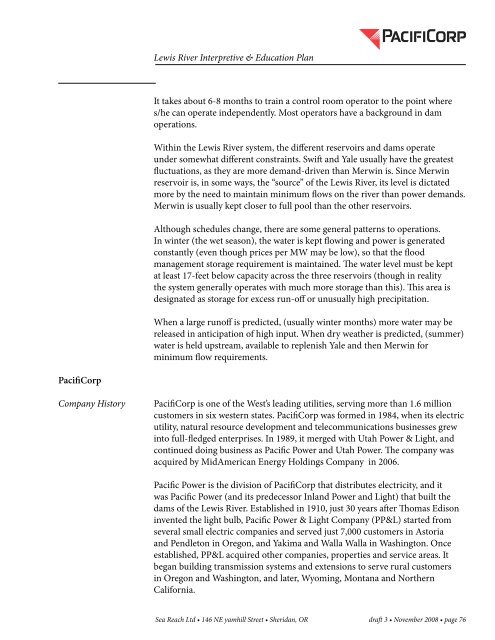The Lewis River Hydroelectric Projects - PacifiCorp
The Lewis River Hydroelectric Projects - PacifiCorp
The Lewis River Hydroelectric Projects - PacifiCorp
Create successful ePaper yourself
Turn your PDF publications into a flip-book with our unique Google optimized e-Paper software.
<strong>Lewis</strong> <strong>River</strong> Interpretive & Education Plan<br />
It takes about 6-8 months to train a control room operator to the point where<br />
s/he can operate independently. Most operators have a background in dam<br />
operations.<br />
Within the <strong>Lewis</strong> <strong>River</strong> system, the different reservoirs and dams operate<br />
under somewhat different constraints. Swift and Yale usually have the greatest<br />
fluctuations, as they are more demand-driven than Merwin is. Since Merwin<br />
reservoir is, in some ways, the “source” of the <strong>Lewis</strong> <strong>River</strong>, its level is dictated<br />
more by the need to maintain minimum flows on the river than power demands.<br />
Merwin is usually kept closer to full pool than the other reservoirs.<br />
Although schedules change, there are some general patterns to operations.<br />
In winter (the wet season), the water is kept flowing and power is generated<br />
constantly (even though prices per MW may be low), so that the flood<br />
management storage requirement is maintained. <strong>The</strong> water level must be kept<br />
at least 17-feet below capacity across the three reservoirs (though in reality<br />
the system generally operates with much more storage than this). This area is<br />
designated as storage for excess run-off or unusually high precipitation.<br />
When a large runoff is predicted, (usually winter months) more water may be<br />
released in anticipation of high input. When dry weather is predicted, (summer)<br />
water is held upstream, available to replenish Yale and then Merwin for<br />
minimum flow requirements.<br />
<strong>PacifiCorp</strong><br />
Company History<br />
<strong>PacifiCorp</strong> is one of the West’s leading utilities, serving more than 1.6 million<br />
customers in six western states. <strong>PacifiCorp</strong> was formed in 1984, when its electric<br />
utility, natural resource development and telecommunications businesses grew<br />
into full-fledged enterprises. In 1989, it merged with Utah Power & Light, and<br />
continued doing business as Pacific Power and Utah Power. <strong>The</strong> company was<br />
acquired by MidAmerican Energy Holdings Company in 2006.<br />
Pacific Power is the division of <strong>PacifiCorp</strong> that distributes electricity, and it<br />
was Pacific Power (and its predecessor Inland Power and Light) that built the<br />
dams of the <strong>Lewis</strong> <strong>River</strong>. Established in 1910, just 30 years after Thomas Edison<br />
invented the light bulb, Pacific Power & Light Company (PP&L) started from<br />
several small electric companies and served just 7,000 customers in Astoria<br />
and Pendleton in Oregon, and Yakima and Walla Walla in Washington. Once<br />
established, PP&L acquired other companies, properties and service areas. It<br />
began building transmission systems and extensions to serve rural customers<br />
in Oregon and Washington, and later, Wyoming, Montana and Northern<br />
California.<br />
Sea Reach Ltd • 146 NE yamhill Street • Sheridan, OR draft 3 • November 2008 • page 76
















